
|
NOTE: You are viewing the OLD VeloceToday website. We are in the process of moving some of the old articles from the OLD site to the NEW site.
|

|

|

|


Home
Cars
Racing
News
People
Lifestyle
Events

|

|

|
Lifestyle
|

|

|
April 5th , 2006
Book Review:
OttoVu Part II: Siata derivata
Review by Carl Goodwin
OttoVu Part I and II
By Tony Adriaensens
CorsaResearch bvba
Raapstraat 20, B-2000 Antwerpen, Belgium
Volume I, Fiat 106 Sport, 672 pages
Volume II, Siata derivata, 528 pages
Total 1000 photos, color and black and white
ISBN 90-1081197-2-5
Price: $475 USD
Order from www.corsaresearch.com
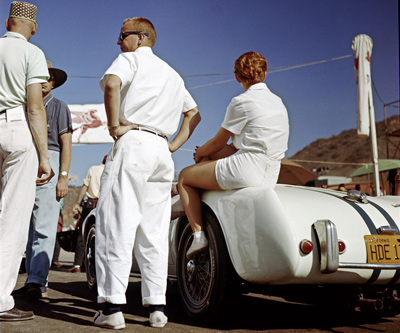
At Paramount Ranch, November 18th, 1956, the Siata 208S of George Dillaway waits on the starting grid. The car, BS526, was sold by McAfee Engineering Corp. to the owner of South Bay Imported Cars in Redondo Beach. Paramount Ranch featured a figure-8 layout with an overpass�underpass arrangement where the track intersected. Photo: Joe Smith�Corsa Research
|
This is the first book review I've ever written and I can't help thinking about a quote my son Douglas gave me. It's from Teddy Roosevelt, who said:
�It is not the critic who counts, not the man who points out how the strong man stumbled or where the doer of deeds could have done better.
The credit belongs to the person who is actually in the arena, whose fat is marred by dust and sweat and blood, who strives valiantly, who errs and comes up short again, who knows the great enthusiasm, the great devotions and spent himself in a worthy cause, who at best in the end triumphs of high achievement and who at worst if he fails, at least, fails while daring greatly so that his place shall never be with those cold and timid souls who know neither defeat nor victory."
I took heed, aware that in writing a review I become the critic who does not count. And Tony Adriaensens, the author of Siata Otto Vu, is to whom the credit belongs.
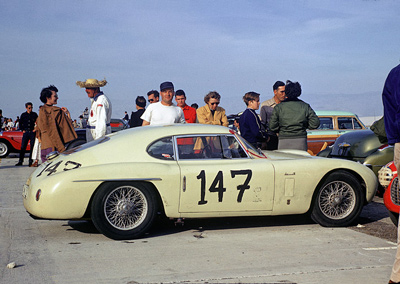
Pictured at Palm Springs in 1954 is the ex-Otto Linton CS060 raced by Bob Murrell. Standing behind the car in a white tee-shirt and dark cap is photographer Joe Smith. During the 1954 season Bob Murrell raced at Palm Springs, Golden Gate Park, Torrey Pines and Buffalo Bill Mountain Hillclimb. Photo: Margaret Smith�Corsa Research
|
There is virtually no person who does not like Siatas, whether they own one or not. They're such charming machines. A pleasure to look at, and a pleasure to drive. Well, Belgian author and publisher Tony Adriaensens has written a book about them: Ottovu. As the title suggests, it is mainly about the 8-V models, but it covers the Gran Sport, the Ferrari-esque Spider and much more. It�s the second of two books in a set, the first volume concentrates on the Fiat Ottvu; click here to read review
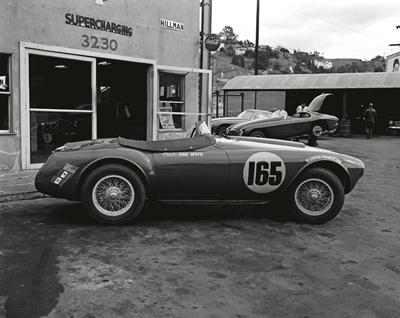
Ernie McAfee�s #165 Siata 208S (BS503), sleeved down to 1600cc, is ready for the Carerra Panamericana Mexico. It�s the legendary �Holey Terror,� lightened and hole-drilled everywhere, with �Piloto Ernie McAfee� painted on the door. It�s pictured in front of his shop on Cahuenga Blvd. with a Touring-bodied Ferrari barchetta in the background. Photo: Joe Smith�Corsa Research.
|
And it's a very nice book � not a perfect book, but a nice one. First of all it is physically big, a square hardbound book that is 10� x 10� x 1-5/8 �, with 543 pages, 312 black & white photos and 90 in vivid color. They�re all fabulous pictures, the result of ten years of intensive research on the marque. It takes us from the company's beginning in 1926 to the mid-fifties, a great broad-brush of this little company�s glory years. Notably, Adriaensens addresses the Fiat Otto Vu engine in considerable detail in Volume I. The design of the book is outstanding, with a modern-sans serif typeface set using plenty of line spacing and a nice handling of photos from 2-page spreads to � page size.
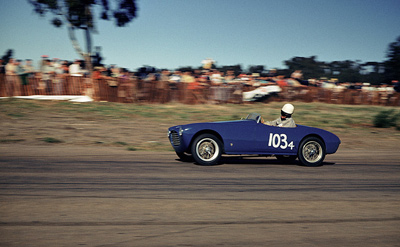
Here�s the little Siata Spider at Torrey Pines December 14, 1952. Driven by Jack McAfee, it was 2 seconds a lap faster than John von Neumann�s Porsche before a brake line failed. Instead of being powered by a Crosley 750 or Fiat 1100, it ran an experimental 1500cc Barker engine. The Barker was similar to an Offenhauser engine. Photo�Bob Lytle.
|
In the Siata volume, Adriaensens has dispensed with the Table of Contents, which is located at the beginning of Volume I on the Fiat Otto Vu. This is a set, and must be viewed as such. But with the Siata volume, Adriaensens gets right into it; very much like Miles Davis' 1975 performance at Walker Auditorium in Minneapolis. Miles just started playing: no announcement of titles, just music. Similarly, Tony launches right into the sections of the book; The Pre-War Years; The Post-War Years; The Daina Series (convertible, coupe, Gran Sport, Sport, etc); 750 Spiders; Ottovu Connection (namely Fiat); the 208CS coupe; Special Projects; The 208S Spider;Ambrosini's Dream (the disastrous Mitzi micro car); Racing History, and The Register. The register is only for the 61 Ottovu cars, says Adriaensens, noting that other models have only been described to paint a picture of the company. Each is described to a �T� and featured pictorially.
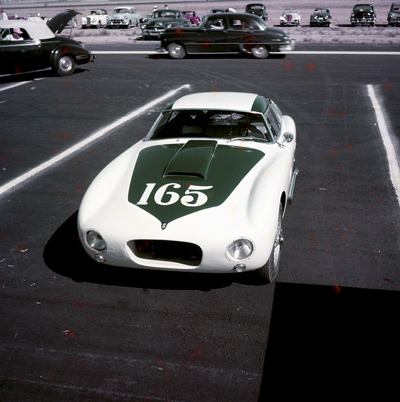
A most unusual Siata 208, this one, BS537, is a coupe built on a roadster chassis. Siata built it to order for Ernie McAfee and Bill Doheny to race in the 1954 Panamerican road race. For some reason, they did not race in Mexico. The car raced at Palm Springs in October, 1954 but did not start the Panamericana November 19th. Photo: Joe Smith�Corsa Research
|
This is a difficult history to write because the cars were, of course, designed and built in Italy, but then most of them were sold and raced in the United States. There is so much that could only be written by a European like Adriaensens and yet so much that needed to be written by an American. Siata and Etceterini expert John de Boer adroitly fills this qualification, and he did provide some research, but perhaps Adriaensens should have had him aboard as co-author. If he had, it would have been the definitive Siata book--but too far out of the focus on the Otto Vu.
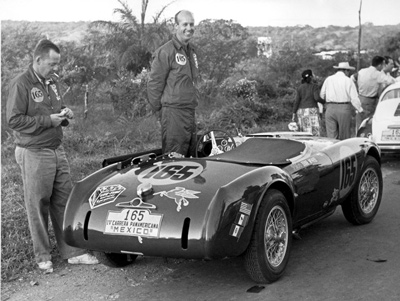
The #165 Ernie McAfee 1600cc Siata 208S (BS503) sits at the side of the road before the start of the first leg of the Mexican road race. The Carrera event plate is on with the number of the car, along the logo of sponsor Life-Time battery and the ubiquitous Mobil Oil flying horse. The little Brooklands racing screen is installed and the tonneau is snapped on, so Ernie is ready to race. Photo: Joe Smith�Corsa Research.
|
The pictures come from a variety of sources and many are from Californian Joe Smith. He's a very fine photographer and he must have had a sixth sense of how important Ernie McAfee�s shop would be. He took photos of things that might have been mundane at the time but which provide interesting detail today. All the book's photos capture the artistic way in which the Ambrosinis did things at Siata. It would have been nice to include pictures of Tony Pompeo�s shops on the East Coast but I don�t know where they would have been found.
The Daina Series (primarily the Gran Sport, in America) is illustrated with several photos of the car in European auto shows and one at the Siata works. There are numerous pictures of the attractive coupe, seldom seen in the U.S. except for the Del Lance car, and photos of interesting technical details. It might have been interesting for the book to examine the connection between the Gran Sport body and that of the Ferrari 225S Vignale roadster.
From the Register section we learn that most of the whale-tooth Stablimenti Farina coupes are in Italy. Pictorial coverage of the #CS055 car features rare photos of Siata founder Giorgio Ambrosini and his son Renato.
Adriaensens� writing tonality is relaxed and pleasant. Of a character in the crowd at a race start, he writes, �the policeman reminds me of John Cleese.� As you page through this fine book, you are struck by the terrific job that the author has done in collecting all these photos.
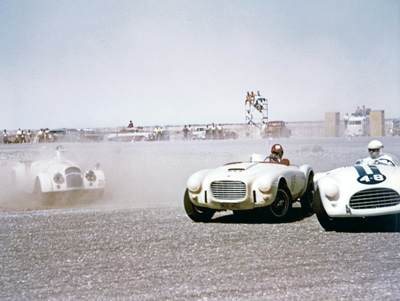
At Palm Springs, October 16, 1957, a Morgan spins as the AC Bristol and Siata take evasive action. Bill Dixon and his cream colored �screaming� Siata (BS521) were a familiar sight around the Southern California road race circuits. Twenty-eight year old Bill Dixon lived in the San Fernando Valley where he owned a barber shop. Photo Lester Nehamkin, collection Corsa Research.
|
A couple of the more interesting cars described are the Ernie McAfee �Holey Terror� an extensively lightened 208 Spider that was sleeved down to 1600cc for the Panamerican road race in 1953, and the exciting competition coupe that was campaigned on the vintage circuit in the mid-90s by Rick Cole.. it was built for McAfee to use in the 1954 Panamericana (but it did not race).
From an American perspective, it would have been nice to have more detail on the John Bentley G-Modified Siata Spyder� the big race for the Dick Irish/Bob Fergus Gran Sport at Sebring in 1952 �and Doug Diffenderfer's 1960 SCCA national championship in the 208S. But those can be gleaned from the periodicals.
As it stands now, there is only one place where you can get the full scope of the Siata story and that is from this book. You will enjoy it.
Bear in mind, it's a very expensive set of books�the Siata Otto Vu is Volume Two of the set. At $475, that�s a lot to pay for a set of books on any marque. But it�s under-priced at that. It should be at least $550. Before long, it will be out of print. Then, when you look for it, it will be $700. Get one while supplies last.
|

|
|

|
|



